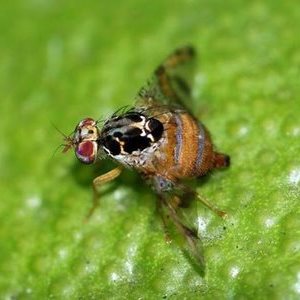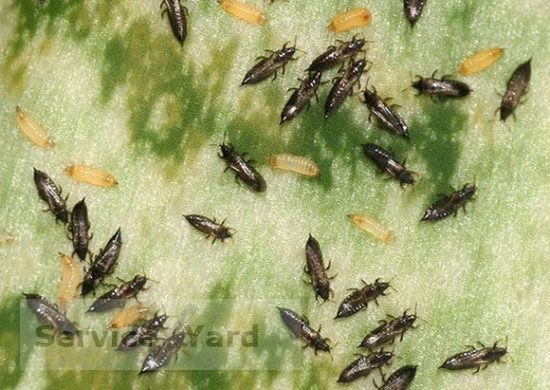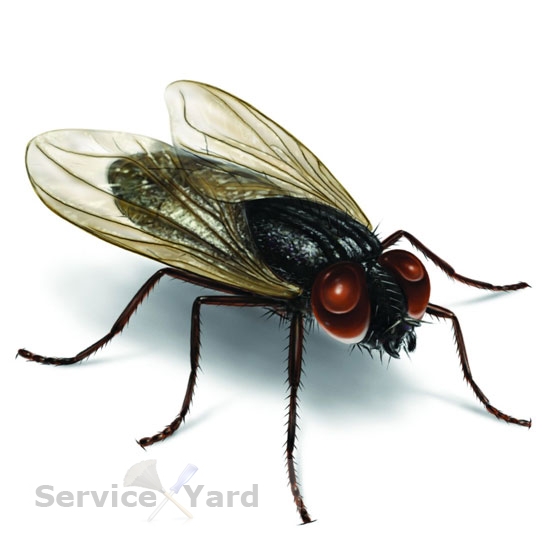Beefly larva 🥝 how to get rid, why die

Permanent companions of man - flies, cause a lot of trouble. They are carriers of various serious diseases, and they are also capable of poisoning a person’s life with their annoying buzzing. Today you can buy any remedy for flies in the store or use well-known folk remedies for fighting, but you must start the war as early as possible, until the insects have time to put off the larvae. How to kill the larvae of flies, how to get rid of the annoying insects themselves, and what preventive measures must be taken to never encounter a similar problem, we will describe in this article.
to contents ↑Why are flies dangerous?
Indoor and house flies are endophilic. Insects constantly fly into enclosed spaces: apartments, shops, houses, cellars and, sitting down on food, can infect them with bacteria that cause not only severe food poisoning, but even death. That is why you need to know how to kill the larvae of flies in order to protect yourself from such an unpleasant neighborhood.
The habitat of flies is ideal not only for the development, but also for the spread of serious diseases, since flying, insects sit on any dirt in places of garbage accumulation. The list of diseases that can cause flies and their larvae is huge, here are some of them:
- Diarrhea.
- Dysentery.
- Typhoid and typhoid fever.
- Cholera.
- Salmonellosis.
- Tuberculosis.
- Anthrax.
- Conjunctivitis.
Important! Flies can also be carriers of parasitic worms.
 In the life cycle, insects go through 4 stages of development:
In the life cycle, insects go through 4 stages of development:
- Egg laying. Flies are ovipositing, and they are very fertile. At one time, the female lays up to 150 eggs. Masonry usually occurs in compost pits, in garbage cans, manure, in any humid environment, favorable for reproduction, but unfavorable for human health. Having flown into the house, the female can lay eggs in rotting vegetables, meat, fish, kitchen waste, which is very dangerous.
- Larval development. From the time of laying the eggs to the appearance of the larva, an average of 8 hours to a day passes. The larva itself develops from 5 to 14 days, eating the food on which eggs were laid.
- Pupation of the larva. The pupation process lasts from 3 to 4 weeks. Before pupation, the larva moves to a dry place, where the process of turning it into a pupa takes place.
- The appearance of a fly. On average, an insect lives about a month. For such a short time, the female can lay from 500 to 2000 eggs.
to contents ↑Important! Flies are seasonal insects. Their greatest numbers occur in the summer months: July and August, however, in places with a dry and hot climate, the numbers and activity peak in June and September. In the summer, flies live next to humans - in rooms, in the kitchen, and in winter - mainly in cellars and cellars.
Fight against flies and their larvae
The fight against the “annoying neighbor” includes the following activities:
- Prevention
- Destruction of larvae and pupae of flies.
- Getting rid of winged flies.
Let us consider in more detail each of the stages of the fight against harmful insects and the means of larvae of flies and flies.
to contents ↑Preventative measures
The easiest way to kill the larvae of flies is to prevent their reproduction in basements, as well as other rooms. This is much easier and simpler than subsequently waging an active struggle with adults.
Prevention is reduced to compliance with sanitary standards, which implies the following rules:
- Keep your house clean. Garbage should be thrown away immediately, and food should be stored in the refrigerator. Initially, ensure that all trash bins, bins, containers, and other sources that attract flies near the house are properly maintained and maintained. All tanks and other containers should be tightly closed, then the likelihood that you will have to wonder how to kill the larvae of flies is significantly reduced.
- If food is stored in the cellar, then regularly check their quality. Preservation, vegetables should not rot.
- All premises of the house should be without gaps. Mosquito nets must be on the ventilation openings as well as the windows. The presence of nets on doors and windows will become an obstacle for insects. Adhesive tape placed in the hallway will not be superfluous, since it is an excellent trap for those insects that wish to enter the house.
- The area around the cesspools, as well as latrines at a distance of 1.5 meters, must be paved or concreted.
- If there is a non-sewage restroom in the courtyard of the house, then it must be cleaned daily and disinfected with a 10% solution of bleach.
- In a house with sewage, the used portable containers must be installed on asphalt and concrete floors, and garbage should be removed daily.
- Around the house, plant special plants that will scare away flies, for example, elderberry bushes, bird cherry trees. Walnut tree and wormwood, growing near the house, also perfectly scare insects. In the apartment, geranium in a pot will cope with the task.
If the problem of the invasion of flies has already appeared, then prophylactic measures must also involve methods of active struggle, using powerful chemical preparations.
to contents ↑How to kill larvae of flies?
Flies lay larvae in rotting substances of organic origin, therefore, at the second stage of extermination of larvae and pupae of flies, larvicides must be used. The fight against insects, especially when it is necessary to kill the larvae of flies, begins with the treatment of liquid waste, cesspools, waste bins and the soil beneath them.
Important! Processing must begin in May, and in the southern regions from April. It is very easy to kill larvae of flies with the help of insecticidal solutions and emulsions. During processing, these substances form a film on the surface, and when the larva rises to the surface, it contacts the insecticide and dies.
Remedies for flies and larvae of flies:
 The surface of the liquid waste is treated with the following larvicides:
The surface of the liquid waste is treated with the following larvicides:
- Aqueous emulsion of dicresil (0.3-0.5%).
- Aqueous emulsion of trichlophos (0.2%).
- 1% solution of malathion.
- Aqueous solutions of chlorophos (2%).
- Aqueous emulsion of 0.5% DDVF (dichlorvos).
Application Rules:
- Freshly prepared solutions are used to kill insects.
- For the preparation of working solutions, the necessary agent is dissolved in water at room temperature, mixing evenly.
- The consumption of the drug is from 0.2 to 1 liter per 1 m2 of cultivated area.
- Processing must be carried out at intervals of 2-5 times per month.
- The frequency of treatment depends on both climatic conditions and the number of larvae: the hotter and drier the climate, and the larger the number of larvae, the more often treatment is required.
When working with working solutions, spraying equipment of various brands is used.
Important! When processing cluttered rooms and basements, first it is first necessary to clean them of debris, and then carefully irrigate the product. During processing, it is necessary to irrigate the external walls of buildings, garbage chambers, as well as garbage bins.
In addition to the listed chemicals, the following drugs also have larmicidal properties:
- Inkstone. Dissolve 800 g of iron sulfate in a bucket of water. It is enough to fill the daily amount of manure from one horse.
- Borax and calcium boric acid kill larvae of flies in manure.Enough 1 kg of borax and 1.224 kg of calcium boric acid per 1 m3 of manure. These substances must be sprinkled with manure, and then doused with water.
- Fertilizer mixtures with calcium cyanamide.
- 5% aqueous solution of extract from hellebore powder.
- Quicklime.
- Sulfur-carbolic mixture (not purified sulfuric acid 1 part, black carbolic acid - 3 parts).
to contents ↑Important! It is much more difficult to destroy larvae and pupae in soil, manure and garbage. To achieve the effect and a good result, they use the same drugs (described above), but in large concentrations:
- from 2 to 5 liters of the preparation per 1 m2 of the cultivated area with a layer of garbage up to 0.5 m.
- from 10 to 12 liters of the drug per 1 m2 with a thickness of more than 0.5 m.
The frequency of processing in such cases also needs to be increased.
Extermination of winged flies
The third stage of insect control is to destroy the winged individuals themselves. They use chemical, mechanical, and folk remedies in the fight.
Chemicals for flies and larvae
Chemicals can be purchased at household stores. The most common of them are aerosols of diclofos, chlorophos.
Important! It is necessary to use these products indoors, and it is imperative to ventilate after processing.
In addition to these tools, you can use the following:
- 2-3% chlorophos solution.
- A solution of a mixture of DDVF with chlorophos in a ratio of 1 to 10.
- Effective insecticidal chlorophos paper.
- Chlorophos tablets.
- Aerosol containers containing DDVF (for example, neofos).
Mechanical methods of struggle
 Among the mechanical methods, sticky tapes, traps with baits with chlorophos, sugars and ammonium carbonate, various fumigators with plates can be noted.
Among the mechanical methods, sticky tapes, traps with baits with chlorophos, sugars and ammonium carbonate, various fumigators with plates can be noted.
So-called attracting substances have proven themselves well. The following are especially effective:
- The so-called “fly agaric”. These are sheets of paper impregnated with toxic substances for insects. Sheets of size 10 by 10 are laid out on plates, filled with water (50 ml) and 0.5 teaspoon of sugar and chlorophos are added. Plates must be placed in those rooms where there is a high concentration of flies. One "fly agaric" is enough for 10-20 m2 of area.
- Poison Bait: Mix 25 g of milk, 125 g of water and 20 g of formalin. Pour the prepared bait into small containers and place it indoors.
- The bait can be prepared as follows: mix 13 ml of water, 4 g of glycerin and 3 g of formalin solution. Mix thoroughly and pour the prepared poison into a plate.
Important! The poison bait is only suitable for non-residential premises, such as a cellar, basement, etc.
Folk remedies for insect control
Folk methods are also effective in the fight against flies, but it would be naive to dream of getting rid of the invasion only with their help. But as an auxiliary measure, folk remedies are really effective.
The smell of some herbs does not like flies. Plant the following plants around the house:
- Basil.
- Bay leaf.
- Lavender.
- Peppermint.
- Tansy.
- Sagebrush.
- Tomatoes
- Elder.
- Fern.
- Walnut.
- Currant.
- Bird cherry.
- Castor oil.
Important! In addition to the smells of trees and shrubs, flies are afraid of the smell of vinegar, so if you regularly treat the basement and places where flies accumulate with vinegar (it is enough to process window frames), then the flies will keep you clear.
Insects do not tolerate the smell of turpentine and kerosene, therefore, to protect against flies, rub the floors in the basement with turpentine mastic, and when washing floors in the room, add a little kerosene to the water and you will forever beat the hunt for flies to winter in the basement or other areas of your house .
If you want to make an adhesive tape yourself, then this can also be done at home in the following ways:
- Make a sticky mass of rosin and castor oil (2 to 1). Spread paper or sheets with this mixture. Hang or lay cooked traps in the places where flies are most crowded.
- For a sticky mass, grind 55 g of rosin to a powder consistency.Add 5 ml of glycerin, 15 ml of vegetable oil, 12 ml of mineral oil, 10 ml of machine oil, 17 ml of castor oil, 1 tbsp. l honey. Stir the mixture well.
- First apply non-drying glue to the paper strips, and coat the paper with the mixture obtained from above. In the room where you plan to place the adhesive tape, there should be no drafts.
to contents ↑Important! Lay out adhesive tape at the rate of: for 20 m2 - 1 tape. One sheet can destroy up to 500 individuals. Burn used bait.
Stock footage
All measures that were considered in the article are effective in the complex. It makes no sense to fight flies only with a flytrap or folk remedies, if you have not destroyed the insect larvae, since this struggle will be endless. Without preventive measures, also any other methods will not bring the desired result, and only the use of all methods of combating annoying insects in the complex will save you from existing “neighbors” and prevent the emergence of new ones.
- How to choose a vacuum cleaner taking into account the characteristics of the house and coatings?
- What to look for when choosing a water delivery
- How to quickly create comfort at home - tips for housewives
- How to choose the perfect TV - useful tips
- What to look for when choosing blinds
- What should be running shoes?
- What useful things can you buy in a hardware store
- Iphone 11 pro max review
- Than iPhone is better than Android smartphones



